It is now two months I haven’t given any update about the developments of the SteemSTEM app, steemstem.io. Whilst I was quite busy with physics, I also did some work, as available on our GitHub folder and summarized in this pull request.
By the way, this post is better formatted on steemstem.io. Feel free to give our app a try! A less technical summary will be released soon (i.e., when I will have time, so that we may need to wait).
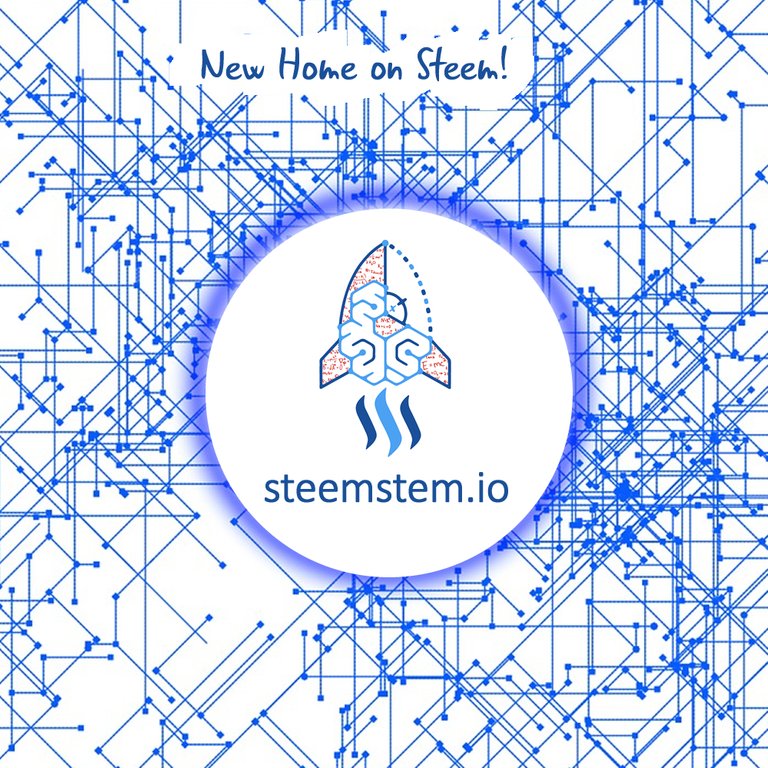
Most changes concern the experience of the user, and in particular comment posting and editing. To celebrate this long-awaited development, SteemSTEM has started to upvote (2%-4%) some of the comments posted through the app.
Moreover, I remind that setting @steemstem as a beneficiary to a post and use steemstem.io automatically yield a stronger upvote (up to 10% more) to any curated post.
1. Post editing
Article preview is now available when an already-posted article is edited by its author. This development necessitated to modify the two files article.html and article.js in the client/views/pages/article/ folder. Some of the changes are given in the picture below to illustrate the adopted strategy.

On the left side of the image, we can see how the article content (title, body and tags) are extracted from helpers, following the standard way the meteor platform (on which steemstem.io is developed) should be used. Those helpers are connected to content updated via the editing form (that has been introduced in a former update) and the Session variable allowing to share information globally through the app client.
On the right side of the image, we can see some of the javascript methods tracking the changes to the post title (top panel) and to the post body (middle panel). Moreover, some of the above mentioned helpers (post title, body and beneficiaries) are shown in the lower right panel of the figure.
In this way, every time an attribute (like preview-body) of the global Session variable is updated by the user editing the post, the corresponding (like preview) part of the HTML page is automatically updated via the helper used on the HTML side.
2. Comments posting, preview and editing
The way comments to posts are handled has been completely changed.
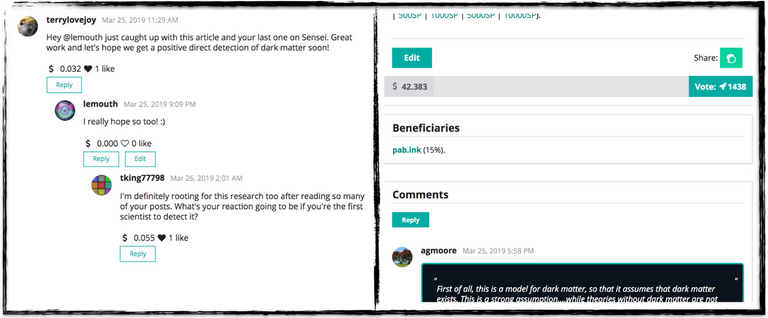
First of all, as shown on the above image, we have more noticeable buttons everywhere: to edit posts, to reply to a post, to reply to a comment to a post, to edit a comment, etc.
The preview of the replies is handled following a strategy similar (but with some differences) to what has been implemented for post preview. First of all, we start with reply.html in the client/views/pages/article/components folder. In this file, we define how a ‘reply’ environment works.

The key point is to assign (via different div environments) different identifiers to the reply buttons, the associated actions, the form in which a reply is typed/edited, etc. This is illustrated in the above image where we can see the association of the parent’s permlink with any button identifier. Similarly, the form in which a reply can be typed in has a permlink-dependent identifier through the class attribute of the corresponding HTML form,
<form class="ui reply-{{../permlink}} form replyform">
All of this hence allows us to assign independent on-click methods with every single button at the javascript level, and consider independently as many reply forms as needed at the HTML level.
The body of the comment is managed in the files comment.html and comment.js stored in the client/views/pages/article/components folder. These two files rely as well on a visible part (the comment itself) and an invisible part (the editing form). The visible/invisible nature of these two parts is controlled by the buttons above-mentioned.
To make a long story short, when clicking on a button, the visible/invisible attributes of both parts are exchanged, and some buttons may appear or disappear.
For instance, in the image below (taken from the reply.js file of the same folder), we present what is going on when a given reply button is clicked: the clicked button is hidden (its style.display attribute is set to none), the content of the reply form is saved in the global Session variable, and the element (i.e. the form) is eventually shown. Moreover, what ever is typed by the user is globally recorded and the preview part updated via an appropriate helper (as for articles, see above).
The image also shows a second example, in which a reply window is closed. Its content is globally saved (through a Session attribute carrying the permlink name) so that it could be retrieved later, the reply form is hidden and the corresponding reply button is made again visible.
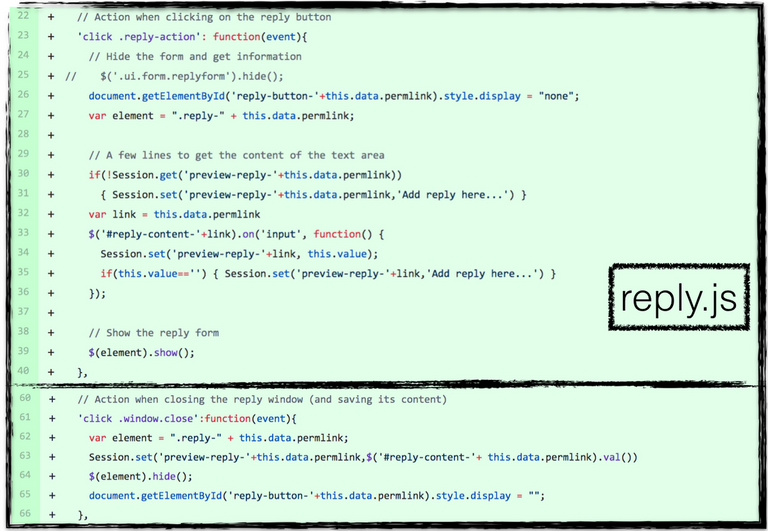
Every single click hence acts on what is visible and what is invisible and stores any modified form globally, at the level of the client. Other examples can be found on the GitHub folder (direct links: reply HTML, reply javascript, comment HTML and comment javascript files).
3. Getting post comments from Steem
The way comments to a post are obtained from the Steem blockchain has been improved. This can be found in the file comments.js (stored in the client/js/collections folder) and in the image below.

All comments are locally stored, by the client, into a Mongo database called Comments and a recursion relation allows to get the replies to a comment. A formatting of the json meta data is performed, and the vote information is extracted and stored as well (see the GetVotes method in the image).
This allows to show the individual contributions of the different votes to a comment, as presented in the image below. The code is extracted from the comment.html and comment.js files.

This illustrates how the list of voters is organized within a popup (see the HTML part), ordered according to their contributions (see the javascript part). The calculation is done as for articles, with a method available from the v0.1 of the app (and thus not displayed here).
4. The blog page on a user profile
Another big development of this v0.7 release concerns the main blog page displayed for any given user. In the previous versions, the app was solely displaying the last 100 posts written by a user. From v0.7 onwards, all blog posts are displayed, organized in pages of 75 entries through which the user can navigate, as illustrated below.
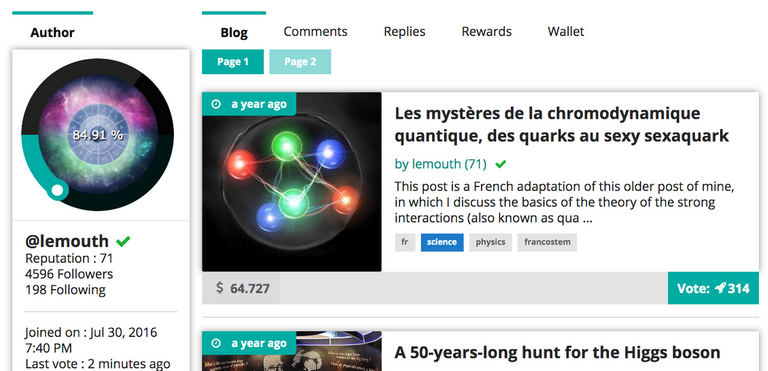
On a given page, posts are shown 25 by 25 and when all 75 posts are shown, a button requesting the next page appears.
First of all, the way posts are obtained from the Steem blockchain has been modified. Queries are made so that posts are retrieved 50 by 50, and a new query is casted only if it is needed to get the next set of 50 posts. This has been implemented in the file blog.js (in the client/js/collections folder), in the routing configuration (in client/router.js) and in profile.js (in the client/views/pages/profile folder).

In the above figure, one observes that when a user blog page (like https://www.steemstem.io/#!/@lemouth) is requested, a bunch of global session variables are set. These variables control the requests to the Steem API, the display of posts and the navigation through the different pages of the user blog. Then, the first 51 posts are retrieved via the call to Blog.getContentByBlog described below.
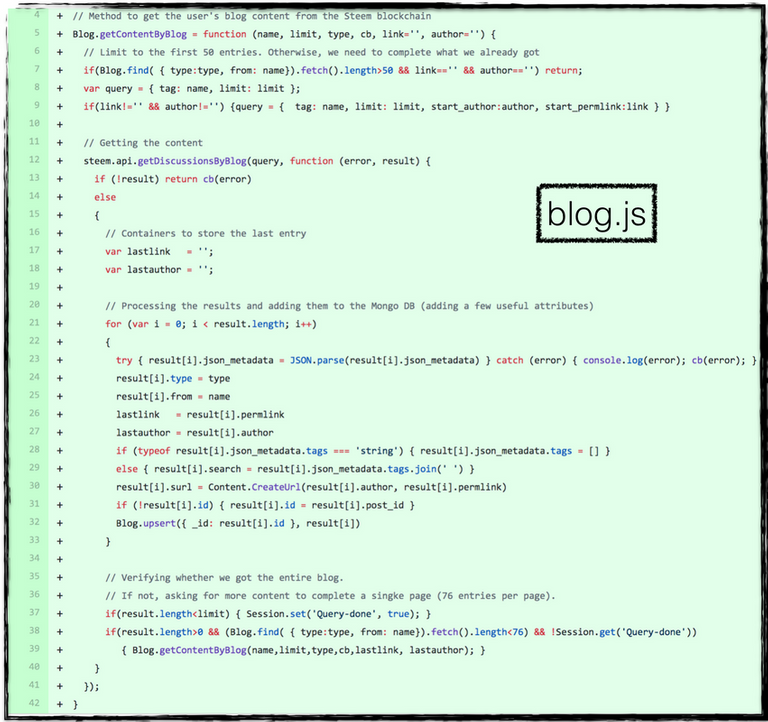
This last method first sets up the API query (that is different if the first posts of a blog are retrieved or if we complete an existing list). The query is then made and the results stored in a Mongo database called Blog. Information on the last retrieved entry is kept so that a second query is recursively made if more posts are needed.

The list of posts to display is obtained from a global helper defined in client/js/collections/collectionshelper.js that browses the Blog database to order and get the posts. If needed, this also triggers a new query to the Steem API to get more content through the usage of the session variable above-mentioned. These variables are also used in the profile.html page through dedicated helpers (defined in profile.js). Both files are located in the client/views/pages/profile/components folder. Moreover, the behavior of the various navigation buttons is also implemented in this profile.js file. We refer to the image above for various snippets of codes related to this navigation system (that is the key novelty for the user blog).
5. Minor improvements
- Markdown is now fully supported thanks the joint usage of the ```kramed``` (on the javascript side ) and standard meteor ```markdown``` packages (via helpers on the HTML side). None of these is perfect, but the usage of both of them at the same time makes it working like a charm. Thanks to @phage and @ikchris for testing these changes.
- There were changes in the way steemconnect was working. The app has been adapted accordingly. For instance, beneficiaries must be ordered, etc.
- The list of tags for posts only carrying the steemstem tag was appearing as a grey square. This has been fixed (checking the presence of at least one tag different from steemstem).
- The about us page has been rewritten.
- The FAQ page has been rewritten.
- The guidelines for post creation have been clarified.
6. Bug fixes in v0.7
- Comments and posts are not bleeding vertically out of their cell when too large images are used. This relies on a standard ```div``` environment embedding each comment/post and carrying the attribute ```style='clear: both;'```.
- Some badges (see the v0.6 update) were not correctly displayed. The spacing was wrong when both of them were needed. This is fixed.
- There were various Firefox-related bug fixes due to a wrong usage of the ```preventDefault()``` and ```stopPropagation()``` method related to ```event``` objects. Beneficiary, votes, shares can now be handled correctly on Firefox, thanks @medro-martin and @eniolw who reported these bugs. Call to these methods have been removed from the ```beneficiarymodal.js``` file (in the ```client/views/pages/create/components``` folder), the ```sharemodal.js``` and ```votemodal.js``` files (in the ```client/views/pages/post/components``` folder) and the ```transfermodal.js``` (in the ```client/views/pages/profile/components``` folder).
- Giving a beneficiary 100% of the post rewards is now possible (strict inequalities have been replaced with non-strict inequalities (see ```beneficiarymodal.js``` file (in the ```client/views/pages/create/components``` folder).
- A few links were not redirecting correctly.
- Blog posts mot upvoted by SteemSTEM are now correctly displayed (when the appropriate box is ticked).
7. More
- Comments have been added in the HTML ```article.html``` (in the ```client/views/pages/article/``` folder) and ```comments.html``` (in the ```client/views/pages/article/components``` folder) files.
- Comments have been added in the javascript ```router.js``` (in the ```client``` folder), ```reply.js``` (in the ```client/views/pages/article/components``` folder), ```blog.js``` (in the ```client/js/collections``` folder) and ```collectionhelper.js``` (in the ```client/js/collection``` folder) files.
- No more dependence on the ```autolinker``` package.
- The files ```edit.html``` and ```edit.js``` from the ```client/views/pages/article/components``` folder have been removed, as comment editing is now handled with buttons.
SteemSTEM
SteemSTEM aims to make Steem a better place for Science, Technology, Engineering and Mathematics (STEM) and to build a science communication platform on Steem.
Make sure to follow SteemSTEM on steemstem.io, Steemit, Facebook, Twitter and Instagram to always be up-to-date on our latest news and ideas. Please also consider to support the project by supporting our witness (@stem.witness) or by delegating to @steemstem for a ROI of 65% of our curation rewards (quick delegation links: 50SP | 100SP | 500SP | 1000SP | 5000SP | 10000SP).
UL LIconstruct. You would probably have achieved the same look using markdown dash-instead ofUL LIYour contribution has been evaluated according to Utopian policies and guidelines, as well as a predefined set of questions pertaining to the category.
To view those questions and the relevant answers related to your post, click here.
Need help? Chat with us on Discord.
[utopian-moderator]
Thanks a lot for the very positive feedback!
I was trying to understand the issue with the back quotes and I am glad you gave me the explanation. Having mixed markdown and HTML is often a nightmare (I tried many options to have something working on steemstem.io). I will fix the post later today, most probably when back home.
Thank you for your review, @helo! Keep up the good work!
Seems like a very significant update.
A lot of work went into this release.
Just a quick comment about the preview.
While markdown specifies that two newline characters are required for sending a block of text to the next line, in practice most Steem apps haven't followed that convention and one newline in markdown is translated into a newline in HTML in those apps.
Initially StemQ was following the markdown convention but some people noticed that the construct of paragraphs was different than on other more popular apps.
So I changed StemQ to be in line with those apps.
So maybe it might be an idea to configure your markdown library to do this as well.
Well done!
Thanks for the comment. I am aware of the subtleties of several Steem apps not following the current markdown syntax and I hesitated longly before deciding what to do. At the end of the day, I decided to stick to standard markdown. We can rediscuss this, but I am actually a strong adopter of the standards are made to be followed paradigm. If there is a need to upgrade/modify the standards, this is one thing. However, here, I honestly don't see the need.
I don't know how you do it all!
Sometimes, me neither :D
Hey, @lemouth-dev!
Thanks for contributing on Utopian.
Congratulations! Your contribution was Staff Picked to receive a maximum vote for the development category on Utopian for being of significant value to the project and the open source community.
We’re already looking forward to your next contribution!
Get higher incentives and support Utopian.io!
Simply set @utopian.pay as a 5% (or higher) payout beneficiary on your contribution post (via SteemPlus or Steeditor).
Want to chat? Join us on Discord https://discord.gg/h52nFrV.
Vote for Utopian Witness!
Have to drop a note to tell you how grateful I am that you work to help SteemSTEM thrive. Technical aspects of your efforts are beyond me. Programming/coding--skills I've never acquired them. Although, I did own an original Sinclair and took an introductory programming course (Applesoft) at the local university years ago.
Still, I sometimes get lost around here. I guess I'm an end-user, a very appreciative end user. So far I haven't signed up on SteemStem-io. I'm opening a second steem account to do just that, and to have access to other apps.
I think it is important for the growth of Steem that end-users who are not schooled in programming feel comfortable here. When I get stuck, my son helps me out. Not everyone has such a son :) And we want this platform to have broad, popular appeal, I think.
Thanks for using your skills for the benefit of the community, and for always being gracious to people who know less than you do.
Thanks for the note! In fact, you don't really need another Steem account to login on steemstem.io. You can use your main account and there will be no problem. Feel free to ty the platform and send me any feedback. This is what I need to improve the platform (and the list of things to do is still just huge! :) )
I actually opened that account--didn't want to use my keys with Steemconnect. Just couldn't bring myself to give permission (authority) to use my functions. So now I'm @agmoore2 and @agmoore. @agmoore2 uses Steemconnect. @agmoore will also be supporting SteemSTEM posts on Steemit.
I have visited Steemstem.io, voted and commented. My next (science) article I will try to post there. That will be my true test.
I love the site. Highly functional and fun. Nice to find articles organized that interest me instead of getting lost in the sea of "trending" or "new".
Just thought I'd get back to you even though it's been a couple of weeks.
FYI, I am now working on supporting steemlogin. keychains is next on the list. This will leave many options for the users.
I'm trying to familiarize myself with all of the opportunities for accessing the blockchain. Delighted that smart people like you are creating them for the community. Thank you!!!